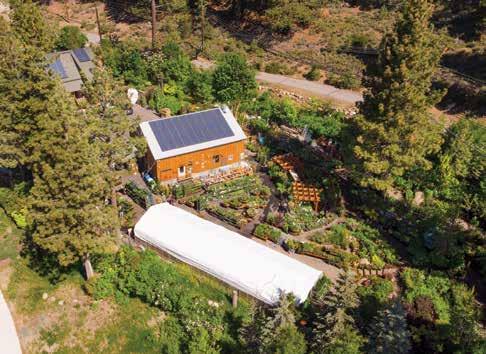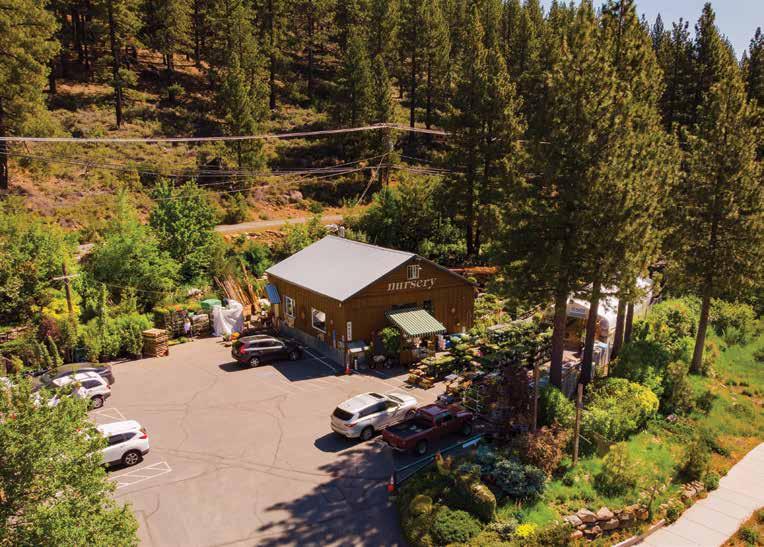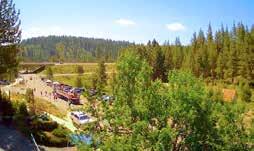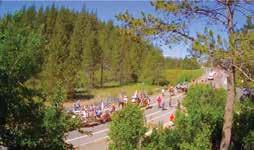
KINDA STUBBORN
ORIGINAL OIL ON CANVAS
TERI SWEENEY


KINDA STUBBORN
ORIGINAL OIL ON CANVAS
TERI SWEENEY




AP R IL 27-30, 2023




GOOD NECKLACE
ORIGINAL OIL PANEL PAINTING


ROGER COOKE
NEW DEPUTY
MIXED MEDIA
DAVID MASON
HOMEWARD BOUND
ORIGINAL OIL ON CANVAS
ROBERT BUCKNELL

publisher: harryJONES
editors: allisonJONES MelanieCano
layout design: aaronJONES
Contributing Writer: MarkMclaughlin
Northwoods Tahoe is distributed FREE in locations in Truckee and Tahoe, also on www.northwoods.news and www.Issuu.com. When you visit our advertisers, please mention that you saw their ad in Northwoods Tahoe. Thank you for your support.
Disclaimer: Articles, if printed, become the exclusive property of Community Media LLC. We reserve the right to edit, or choose not to print submissions. The views and opinnions expressed in the content of Northwoods Tahoe are not necessarily shared by the Publisher, Editor, Community Media LLC or anyone else.
2292 Main Street, Suite 101, Genoa, NV 89411
Mailing: PO Box 1434 Genoa, NV 89411
For advertising: (530) 582-9012
email: harry@communitymediallc.net
(775) 301-8076
WWW.NORTHWOODS.NEWS
WWW.TAHOEWEATHERCAM.COM
© 2000-2022 Community Media LLC. Reproduction of any part of this publication by written approval only.
Continued from Northwoods Tahoe March 2023
When Lieutenant John Charles Frémont led his haggard band of men in a desperate attempt at a midwinter crossing of the Sierra Nevada range in 1844, the odds were stacked against them. They had little food or supplies, knew nothing of the rugged country they were entering, and storms had buried the mountains in deep snow. Frémont had chosen to ignore advice given him by the Paiute Indian, Chief Truckee, who told him to cross the mountains at the pass west of present-day Donner Lake.
Despite warnings from local Washoe Indians, Frémont and his men were resolved to reach the safety of Sutter’s Fort located in the Sacramento Valley. The men rigged sleds to carry their remaining supplies of food and equipment and began climbing up

the east fork of the Carson River. Their situation was critical. Frémont wrote, “We suffer much from the want of salt; and all the men are becoming weak from insufficient food.” They took turns breaking trail on horseback; when the snow became too deep, they pushed forward on foot. To make a path for their pack animals, they were forced to pound down the snow with hand mauls. Burdened with cumbersome scientific equipment and a bulky collection of minerals and plants gathered during their exploration, the men, horses and mules were soon exhausted. Frémont wrote, “…we attempted in the afternoon to force a road, but after a laborious plunging two or three hundred yards our best horses gave out, entirely refusing to make any further effort. The [Indian] guide informed us that we were entering the deep snow and here began the difficulties of the mountain; and to him and to almost all, our enterprise seemed hopeless.”
Occasional snowstorms plagued them, as did bouts of snow blindness, which they tried to mitigate by wearing scarves over their eyes. On Feb. 6, 1844, Charles Preuss, the expedition’s German topographer,
Continued on page 4
Artist rendering of Sutter’s Fort 1847 Photo Courtesy of Library of CongressContinued from page 3 wrote in his diary, “The snow is so horribly deep, and we can cover only a few miles each day. I am walking almost barefoot. This surpasses all the hardships that I have experienced until now.” Two days later, they get their first view of the Sacramento Valley, some thirty miles away. The group’s legendary scout, Kit Carson, identified Mount Diablo one hundred miles distant, from his exploration of California fifteen years before via the Mohave River. The promise of reaching the lush green valleys of California buoyed everyone’s spirits and it came just in time. Their food supply was dwindling rapidly. In fact, on Feb. 13, Frémont wrote, “We had tonight an extraordinary dinner — pea soup, mule, and dog.”
On February 14, Valentine’s Day, Frémont and Charles Preuss, climbed the dividing ridge of the Sierra crest where they “discovered” Lake Tahoe, about 20 miles to the north. History records them as the first Euro-Americans to see the magnificent lake, but celebrated trapper, Stephen C. Meek, claimed to have been the first Caucasian to see the Truckee River when he set traps on it in 1833. It seems unlikely that Meek would not have followed the relatively short Truckee River to its source, Lake Tahoe. Ironically,

if Frémont had followed Chief Truckee’s suggestion to ascend the Truckee River drainage, he would have never seen Lake Tahoe.
Indicative of the stress and danger they were facing in their mid-winter mountain crossing, Preuss didn’t even mention Lake Tahoe in his daily notes, and Frémont also treated the event very casually. Frémont’s comments offer a glimpse of that moment: “With Mr. Preuss, I ascended today the highest peak to the right [Red Lake Peak]; from which we had a beautiful view of a mountain lake at our feet, about fifteen miles in length, and so entirely surrounded by mountains that we could not discover an outlet.” But on other occasions, Frémont did fall under the spell of the High Sierra. He wrote, “Scenery and weather combined must render these mountains beautiful in summer; the purity and deepblue color of the sky are singularly beautiful; the days are sunny and bright, and even warm in the noon hours; and if we could be free from the many anxieties that oppress us, even now we would be delighted here; but our provisions are getting fearfully scant.”
Two more weeks of struggling through rugged canyons and deep Sierra snow finally brought the weary expedition into the Sacramento
Valley, and on March 6, Lt. Frémont and his men stumbled into Sutter’s Fort, where John Sutter treated them like royalty. Despite their ordeal, not one man had been lost.
In his 1845 report, Frémont called the largest lake in the Sierra Nevada “Mountain Lake,” while Preuss’ map of 1848 identifies it as Lake Bonpland, in honor of the French botanist Amie Jacques Alexandre Bonpland. Although the name, Tahoe, derived from the Washoe tribal name, Da ow a ga (“edge of the lake”) was in common use by the 1860s, the lake was officially renamed Bigler in 1854. (John Bigler, third governor of California, had personally led a rescue party in 1852, from Placerville over Echo Summit to save a group of snowbound emigrants.) Bigler was the official name until 1945, when the lake was at last legally established as Lake Tahoe.
John Charles Frémont enjoyed remarkable fame in the 19th century, enough to run as the GOP candidate for President of the United States in 1856, although he lost to Democrat James Buchanan. Considered the preeminent explorer of the uncharted American West, Frémont was known as the “Pathfinder,” although one biographer more correctly called him the “Pathmarker.”




Due to their small size and heavy usage, bathrooms can become messy, cluttered areas for many families.
For those with smaller bathrooms, storage solutions can be even harder to find. Consider these organization tips to make your bathroom a clean and functional space for every member of the family:
Assess the mess: Go through all the cabinets and drawers to clear out unused makeup, health care products and medications. Make sure the items you keep are used on a regular basis. Items used sparingly should be placed in an alternate location.
Go vertical: Medicine cabinets can quickly get stuffed when combs, toothpaste and other toiletries are stored horizontally. Use organizer cups with suction adhesives to contain items vertically and save space.
Hang up in style: Old coat racks and ladders make perfect solutions for larger families to hang multiple towels. Snag an old one from a thrift store and paint it a bright hue, like red or turquoise, for a stylish bathroom accent piece.
Avoid spills and squirts: Hair products, such as gels, mousses or hairsprays, can create sticky, tough-toclean messes if liquid escapes the container in a drawer or cabinet. Avoid such mishaps by placing these types of items in plastic tubs instead of directly in the drawer or on a shelf.
Divide and conquer: Bathroom drawers can become unruly if not organized. To keep items separate and tidy, insert dividers, such as those used for kitchen utensils. These often come in fun materials, such as bamboo or stainless steel, to add a fresh look.
Assign cabinets or drawers: Try to use a large enough cabinet so each member of the family has his or her own space or drawer. This can help limit the amount of items high-maintenance family members can bring into the small area. Plus, it makes it easier for everyone to find their things.
Find more tips to transform your bathroom into a clean, organized environment, regardless of its size, at eLivingtoday.com. Photo courtesy of Unsplash








In our 23rd year of publishing, we want to take a moment to reflect on why we call our magazine Northwoods. In 2000, when we began, it was important to tie ourselves to the area, and chose as our name, the actual road on which our office was located, Northwoods Boulevard, in Truckee. At that time, we knew the name we chose meant much more to us, but did not expound. Now, because so many of our readers have experienced changes such as they have never seen before and simple pleasures have become so much more important, it’s time to give a broader explanation.
We were raised in Michigan in the Great North Woods, an expanse of quiet, forested land stretching from Minnesota to the wooded areas of New England. Not all of Michigan is North Woods. In fact, it was quite evident while driving north, when we had finally arrived there. Unlike the noise and bustle of southern Michigan, it was full of beautiful green forests, lots of wildlife, small rustic cabins on hidden lakes, many rough forest lanes with grass in between the tire tracks, and quiet like we never experienced anywhere else. The “expressway” as Michiganders called it, would only take one so far. Then it was up to whatever directions you were given by your Uncle Bill, or the man who owned the corner store, just which tiny state routes and turns on dirt roads would get you to the quiet of a peaceful lake and a roaring fire.
The Great North Woods became popular after the 1920’s when automobiles transported residents of the northern states, “up north”. For about 40 years, wonderful lodge style cabins sprouted up on lakes and rivers, with large-beamed ceilings and fieldstone fireplaces. Many had outhouses for bathroom facilities and that was okay, because it was still better than camping. Those who owned their cabins always put their cast off furniture and old clothing “up there” along with many board games, decks of cards, chipped dishes and plenty of extra
blankets, pillows and sleeping bags. Fishing equipment and rustic snow shovels littered the walls or any available closet space, while jars for catching “lightning bugs”, some already filled with pretty stones from the lake, lined the small kitchen cabinets.

Another aspect of being “up north” was being out of touch with everyone, no television and no telephones. (It was all we had then.) There was never a worry when we really didn’t know what was going on in the world…we had the lake and the lightning bugs to keep us occupied.
What many of us remember about those times are the pieces of rickety furniture, the creaky screened doors that would slam shut and the sand that found its way into everything in the cabin. In the winters we remember the bitter cold outside with the roaring fire in, the unfortunate trips to the outhouse in the middle of the night and carrying water from the lake if pipes froze.
So much about the lifestyle we recall in the Great North Woods is here, in Truckee and Lake Tahoe. When we moved here in 1988, we remarked on it…about how much of what was here, reminded us of our days in Northern Michigan…the sand, the snow, the peacefulness and above all, that ability to come here and forget the cares of the rest of the world. Of course technology has caught up with us and that last thing is no longer easy to do…one has to choose to stay out of touch.
As we continue the Northwoods Tahoe in 2023, we do so to represent a place where people come to relax, get away and experience that deep quiet that can only be found in the woods. We hope that our readers will continue to live here, play here and long for “here” whenever life gets tough, and even when it doesn’t.
Harry and Allison Jones –Publisher and Editor, Northwoods Tahoe






Family photos, vacation pictures, candid snapshots of friends and family – they’re often visual representations of some of your most treasured moments, so it’s likely you’ll want to give them some special treatment.
Consider these easy and affordable ways to showcase some of your favorite photos.
Variations on a theme – You don’t have to have a whole set of matching frames to create a unified look. Gather frames of different sizes, shapes and textures then paint them all the same color. White, cream or black are colors that let the eye focus on the photograph. Then when you group them together, you’ve got a cohesive display without everything being the same.
Location, location, location – Photos don’t always need to be on a wall or shelf. Try hanging a series of related photos on the back of a door or between windows.
A new use for old frames – Take a large frame with no back and paint it. Then take two pieces of ribbon or wire and attach them to the back of the frame, dividing it into three sections. Attach small photos to the ribbon or wire with mini clothes pins or other small clips.
New frames out of old windows – Fit a photo mat inside each pane of an old window. Attach photos to the backs of the mats and you have a vintage frame.
Map it out – Showcase favorite travel photos by covering a mat with a map from one of your vacation spots. Just trim the map to fit your mat, tape it to the back and insert your picture.
Get it on canvas – Treat your photos like the works of art they are by having them printed on artist canvas. There are a variety of online vendors that let you choose the size and photo treatment to create a unique piece for your personal gallery.
Put it all on the table – Add to your stylish decor and protect your furniture all at the same time by making your own photo coasters.
Find more ideas for creatively displaying your favorite photos at eLivingtoday.com. Photo courtesy of Unsplash





Common Hop, Humulus lupulus (“wolf of the woods”) is a member of the very small Cannabaceae family. The Canabaceae family includes Cannabis (hemp), Celtis (hackberry), Trema and Humulus (hop). Both Nettles and Elms are also closely related. “Hops” are the harvested flowers from hop plants.
Humulus lupulus is a circumboreal species (native to the cooler portions of the northern hemisphere) with three varieties of common hop considered native to North America and another to Europe. There are also two separate East Asian species.
In California, Humulus lupulus var. neomexicanus is only considered native in Plumas County (also Washoe County, Nevada) though it can be found thriving in many long-abandoned mine-shacks, homesteads and ghost towns throughout the west. Hop is the only introduced plant still thriving in Bodie, California, a high desert, Great Basin ghost town at 8,300 ft. elevation with as little as 6.3 inches of rain per year.
Hop was always one of the first plants in the ground in every settlement, along with apples, for obvious reasons; “strictly for medicinal purposes…” There are hundreds (likely thousands) of historic hop patches growing in Truckee, Boca, Polaris,

Common hop is dioecious, with male and female flowers on separate plants. Like Cannabis species, the female flower (strobile or “cone”) contains the resin and oils favored for use by humans for millennia. Cannabis is even occasionally grafted onto vigorous hop rootstock. It is suspected that humans have moved hop plants around agriculturally since prehistoric times, so much that, it is difficult to discern where common hop may have actually originated. Hop is technically an herbaceous perennial “bine” not a “vine”. Bines have no tendrils to use for climbing. Hop uses tiny spines on
Continued on page 14
















its stems and leaves to wrap itself clockwise up other shoots and whatever else it can get it’s claws into. Being an herbaceous perennial, the shoots (up to 30 feet tall in a season) die all the way back to the hardy root-crown.

The U.S. produces almost 25% of the world’s 98,000 tons of hops, mostly from the state of Washington (Germany produces more). Commercially, hop is trained to grow up strings suspended from 20- to 30-ft. trellises and the shoots and string are cut down to harvest the cones, or hops.
Hop appears to be first used in beer making in the 700s as the Vikings were raiding the coasts of Europe and a poet was composing Beowulf The resins in hop give beer bitters and the oils provide the wonderful floral or citrus aromas. Man has been making beer for thousands of years and before hop was used, many other herbs were used for flavoring, buttering and to improve its shelf-life.
Hop has dozens of uses other than for use in beer. The bines, as in nettle and cannabis, are very high in fiber and have been used for rope since prehistory. The herbal properties of hop used by indigenous peoples from Asia to India, to North America include use as an analgesic, astringent, antibiotic, antispasmodic, diuretic, sedative and much more.
Hop is easy to grow and cultivate in Truckee/Tahoe. In the nursery, while we focus on being the best source of natives in the Sierra, we have a fondness for long-live historical troopers like peony, lilac, apple and hop. We try to always have a supply of named cultivated variety hop for folks to plant like ‘Cascade’ or ‘Nugget’ or ‘Tettnanger’. Hop is propagated from root divisions and
the clones produced for planting are always female.
It grows well and produces the most cones in full sun, but the fo liage sunburns and the plants can look ratty by summer’s end. Hop is one of those plants that look great from afar (or as my business part ner says “they look great in some one else's yard”). I have mine in dappled shade, growing up a post out next to the road and it looks lush driving by and from across the yard. One cultivated selection of hop (golden hop) has clear yellow-green foliage that looks fantastic in bright open-shade at the back of a garden.
Hop is notoriously susceptible to aphids and spider mites. If I fertilize with neem-seed meal and wash the growing shoots with soap a few times mid-season, the problem is kept to a minimum. Between the tiny sharp spines and the bugs, hop is really not a great choice for a back-yard arbor; there are excellent vigorous and showy small-flowering clematis that are far better choices.
If you goal is to gather hop cones for beer making, there is no other choice and while I may not have it front and center in my garden, I love to grow it and I am grateful for its ease and vigor and especially it’s aromas at the end of a very long spring day.
Editor’s note: We wanted to usher in the brewfest season in Tahoe and Truckee. Just remember where it all begins! Eric Larusson is owner of Villager Nursery and has been botanizing and gardening in the Sierra since the early ’70s. In the nursery, he’s killed thousands of plants (experimenting) so his clients won’t have to.


















Prepare for the change of seasons with a large variety of products to match all your interests. Mountain Hardware and Sports has an extensive selection of products for any season including all the apparel and gear you'll need for wherever adventure may take you.







EVERY ADVENTURE. EVERY PROJECT. EVERY SEASON


